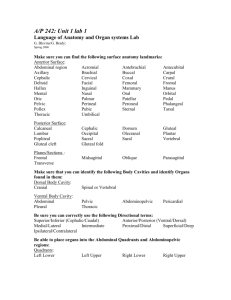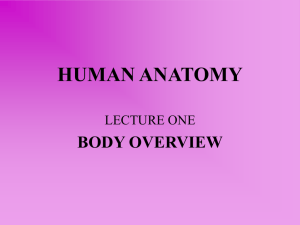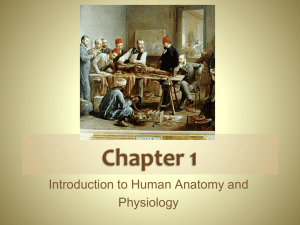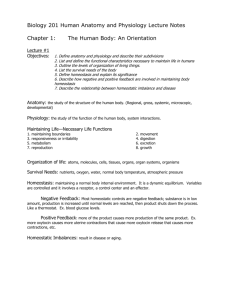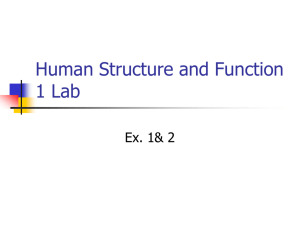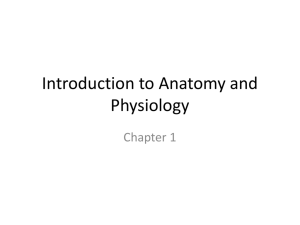Ch 1 Organization - Miss Gleason's Science
advertisement
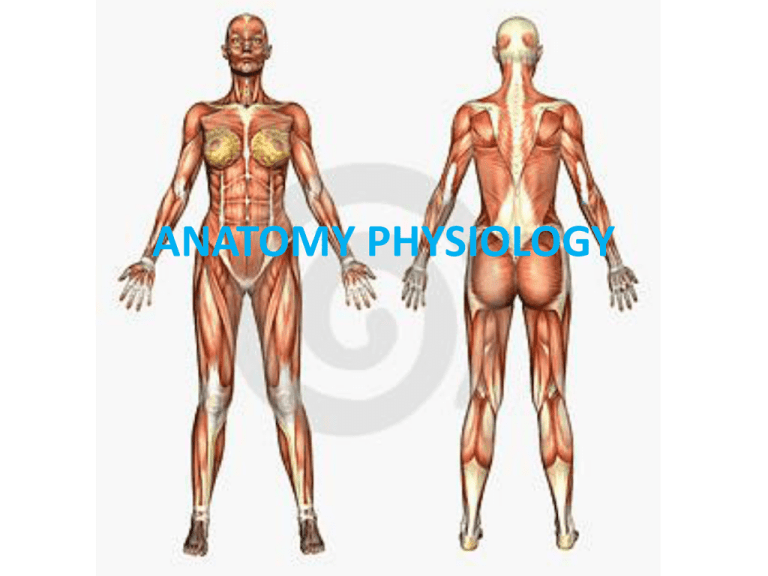
ANATOMY PHYSIOLOGY • Anatomyexamines structures/morphology of body parts, forms, organization • Physiologyfunction of body parts • Human organism-is an organized unit Levels of organization Subatomic part(e−,p⁺,nⁿ)atomsmoleculesmacromolecules Cells- basic unit of structure + function Tissues- cells organized into layers/masses w/ specific funct. Organs- groups of tissue - complex structures w/ specialized function Organ system- groups of organs that function together Organism- interacting organ system atoms/molecules Cells small intestine tissue Digestive system Human organism small intestine Characteristics of Life • Movement • Responsiveness • Growth • Reproduction • Respiration • Digestion • Absorption • Circulation • Assimilation • Excretion = metabolism- physical/chemical events that obtain, release, and utilize energy Mental Mapping • • • • • • • • I am walking to Mcdonalds (movement) I stop at the traffic light (response) My body is growing (growth) I am breathing air (respiration) I get a hamburger and eat it (digestion) My body absorbs the hamburger (absorption) The hamburger circulates in my body (circulation) The hamburger is changed to things my body needs (assimilation) • Eventually, I go to the bathroom (excretion) • Someday I may reproduce (reproduction) Requirements of Organisms 1. Water- most abundant subs. In body – Required for metabolic processes – Environment – Transport – Regulating body temp 2. Food- provide nutrients 3. Oxygen-gas (1/5 of air) – Used in process of releasing energy from nutrients – Energy drives metabolic process 4. Heat- energy in body – Product of metabolic processes – Controls rate which process occur – More heat= faster reaction 5. Pressure-force – Plays an important role in breathing – Hydrostatic Pressure- exerted by liquid • EX: blood pressure Homeostasis • Bodies maintenance of stable internal environment – Remains stable despite changing environment - Takes most metabolic energy Homeostatic mechanisms • Self regulating control systems (3) 1. Receptors- give info about conditions in internal envir. 2. Control center- set point EX: body temp 98.6˚ 3. Effectors- response that alter conditions • Receptors measure deviations from set point effectors activated to return cond. to norm. • Negative Feedback- deviation is corrected to set point Ex: Room temp 70˚F- air condition/furnace Set point= 70 ˚ Air Condition/Furnace = effector Thermostat= Receptor • Body Homeostatic mechanisms -body temp -reg. of blood pressure -concentration of sugar/glucose • Positive Feedback – process which moves conditions away from normal state - Ex: blood clotting- chemicals stimulate increase clotting to decrease bleeding Organization of Human Body • Axial portion- body, neck, trunk • Appendicular-arms/legs • Cranial cavity- brain • Vertebral canal- spinal cord surrounded by backbone vertebrae • Thoracic cavity and Abdominopelvic cavity – Viscera- organs within – Diaphragm separates • Thoracic cavity- lungs, mediastinum, heart, esophagus, trachea, thymus gland – Right Pleural- right lung – Left Pleural- left lung – Mediastinum- esophagus, trachea, thymus gland • pericardial cavity= heart • Abdominopelvic cavity- upper/lower pelvic portion – Abdominal Cavity-stomach, liver, spleen, gallbladder, small intestine – Pelvic Cavity-lg. Intestine, urinary bladder, internal reprod. organs Small head cavities • Oral cavity- teeth + tongue • Nasal Cavity- divided into right/left sect. By nasal septum – Sphenoidal + frontal sinuses • Orbital cavity- eyes, skeletal muscles, nerves • Mid Ear Cavity- mid ear bones • Serous Membrane - two layered, covers organs – Outer layer = parietal – Inner layer = visceral (lines the organs) • Serous fluid – lubricating fluid • 3 Major Locations 1. Pleura: lungs 2. Pericardium: heart 3. Peritoneal: abdominopelvic cavity Membrane Names Parietal Pleura / Visceral Pleura Parietal Pericardium / Visceral Pericardium Parietal Peritoneum/ Visceral Peritoneum ORGAN SYSTEMS Body Covering Integumentary system - skin, hair, nails, sweat glands - Protects tissues, regulate body temp., house sensory receptors Support/Movement Skeletal System - bones, ligaments, cartilage - framework, protective shields, movement Muscular System - Muscles - Contract/pull end together= movement, maintain posture, source of body heat Integration/Coordination Nervous System - brain, spinal cord, nerves, sense organs - detects inside/outside changes= body reacts Endocrine System - pituary, thyroid, parathyroid, adrenal gland, pancreas, ovaries, testes, pineal gland, thymus - Glands that secrete hormones Transport Cardiovascular system - heart, arteries, capillaries, veins, blood - Blood transports, gases, nutrients, hormones Lymphatic system - Lymphatic vessels, lymph fluid, lymph nodes, thymus, spleen - Transports fluid - Lymphocytes-cells defend against pathogens Absorption/Excretion Digestive System -mouth, tongue, teeth, salivary glands, pharynx, esophagus, stomach, liver, gall bladder, pancreas, small/lg intestines - breaks down food, absorbs nutrients, excretes waste Respiratory System - Nasal cavity, pharynx, larynx, trachea, bronchi, lungs - Exchanges gas b/w blood and air - Oxy in, CO2 out Urinary System -kidneys, ureters, urinary bladder, urethra - Removes waste, stores/excretes urine Reproduction Reproductive system (male/female) Male- scrotum, testes, urethra, penis - produce/maintain/transfer sperm Female- ovaries, uterine tubes, uterus, vagina - produce/transport eggs - Receive sperm - Supports embryo Anatomical Terminology • Anatomical position: – Standing erect – Face forward – Upper limbs at sides – Palms forward • Superior- above • Inferior- below • Anterior- toward front • Posterior- toward back • Lateral – toward side with respect to midline Ipsilateral-pertains to same side Contralateral- refers to opposite side • Medial- midline divides into equal left/right sides, closer to line is medial • Proximal-closer to the trunk of the body • Distal- farther from trunk of body Body Sections • Transverse- (horizontal) divides body into inferior and superior portions • Coronal- divides body into anterior/posterior portions • Sagittal- lengthwise cut right/left portions – Midsagittal- sagittal sect. Passes along midline – Parasagittal- sagittal sec passes parallel to midline • Cross section: cut across structure • Oblique section: angular cut • Longitudinal- lengthwise cut Body Regions Pg 23 Quadrants http://www.wisc-online.com/objects/index_tj.asp?objID=AP14904
